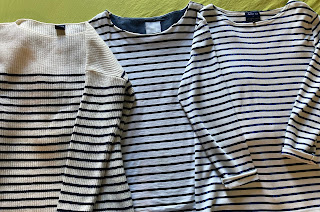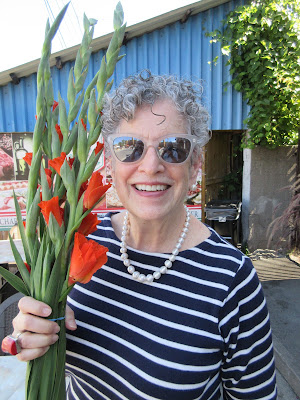Buy and Hold: Bridgette Raes on "Splitting Your Wears"
I've just donated a few bags to a charity store, and noticed my tendency to buy nearly-identical versions of the same thing: a dive into our storage locker revealed five white-and-navy mariniéres and enough sports bras to outfit the Las Vegas Aces. Shown, three tops that I'm keeping:
 |
| From left: Gap heavy cotton; Next midweight; AmorLux lightweight |
Clearly I need help, and though Mr. Buffet is with me, he is interested in what a professional in this field thinks. (Sidebar: This is Warren, not Jimmy. Jimmy would want you to just buy a new bikini and kick back.)
The stylist and author Bridgette Raes (Bridgette Raes Style Group) says my stack is called Splitting Your Wears: "(This is) when you have too much of the same thing playing the same role in your wardrobe, so nothing gets worn enough to deliver value." When you buy, she says, think it through. Each piece should retain its value, because "if you put too much money towards owning too much duplication, you spend what could be used to create a diversified wardrobe." "Diversified" does not mean "more", it means "delivers what you need."
She blames over-saturation for resulting in both the "lots of clothes but nothing to wear" situation, and wardrobe boredom, which has caused my biggest mistake: the I-should-break-out-of my-rut purchase. Mr. Buffet likes her forthright handling of such buys: create a capsule for the week and include it. If, during the week, you cannot bring yourself to wear it, or you wear it and you don't like it, it goes.
For multiples, she makes a couple of exceptions.
 |
| Raes' bootie bounty |
Raes shows her six pairs of Aquatalia booties and explains how they spread the wear among them, so these pricey, perfect booties will last a very long time. (She bought most secondhand.) She has diversified by buying various colours and heights.
My three pairs of black brogues squeak into the OK to Split category, but she would advise swapping one pair for another colour.
 |
| Left, Nasser Vies, bespoke; centre, Charles David; right, Accessoire Diffusion |
She also OKs multiples of staples such as white or navy tees; the marinères are close, right? But if I need a fresh one, they are always out there. I donated two.
"High-Function Boredom"
Another Raes-ism happens when you love something so much that you wear it endlessly, and come to hate it. She describes a client's perfect lightweight puffer: "the very best thing in her wardrobe...worn to death. Her reliance on the coat (still in good shape) had created an 'over it' feeling."
The fix is to buy a second coat with the same magnificent functionality, but "diverse enough from the original, so it feels fresh."
So you can build up in a few cases, but Raes thinks Splitting Your Wears is the buying error. She has more useful tips and ideas; to subscribe to her free newsletter, use the link on her home page.
The Dressing Room Question
Clearly it's far better to buy more strategically, so we don't waste money.
When considering a purchase, I will ask myself, "What do I already have that isn't going to be worn if I get this?" This is more exacting than "Will I wear this often?" I also need to resist duplicating the same palette: there's white and navy, and then there's navy and white...
There is congruence between Buffet and Raes' investing principles: value is more important than price; resist emotional decisions; diversify thoughtfully.
That approach does not excise pleasure. Personal adornment is not solely about functionality; we don't wear stock certificates. However, the current economic system, built to stoke desire and impulse, depends upon reflexive, continual consumption.
Believe me, sisters, those five marinères rang my alarm bells, and even the usually affable Mr. B. raised an eyebrow. As famous for philanthropy as for investing, he likes that they went to a local charity shop that helps women in need.




Comments
Thanks.
LauraH: Yes, and somehow even with the questions I can still be led down a path of "what was I thinking/"!
Laura J: You are not alone. There are several reasons why we hang on to things (and concurrently buy more) but let's give ourselves credit for learning as we go.
francesray: Thank you for breaking the silence ;) I too have more in different colours, those were just the blue/whiite.
For example, I found a boat-neck summer top with thin stripes and three-quarter-sleeves which I liked a lot. So I bought it in 4 colours. I also have 3 identical - other than in colour - short-sleeved striped tops (broader stripes this time!)
Then there are the 4 identical drapey jersey tops, again in different colours. All my jeans are the same brand and style in white, camel, dark blue and black. For summer, I have exactly the same Bengaline trousers in 5 colours ranging from black through neutrals to white.
My trusty macs are the same brand and style, just different colours
And perhaps I shouldn't mention the 3 identical white cotton sleeveless button-down shirts that I wear in rotation under sweaters in cooler weather... I could go on.
Oh dear. I wear all the clothes in my wardrobe, and all these items get regular use, but I am honestly quite disconcerted to realise the extent to which I duplicate in this way. I am trying to work out whether this makes me unimaginative, lazy, consistent, timid, disciplined - or all of the above! ;)
re "uniform dressing", some uniform dressers are minimalists who want very few pieces, and find that freeing. Other uniform dressers have a much fuller closet but it is tightly edited in terms of colour and style. The minimalist may have four nearly-identical shirts, the other may have ten.
I have a few Pink Tartan striped tops in various colour ways. Purchased at Costco of all places but well made, fit well, wash well better quality than my J. Crew version. I vacillate between black in cool months and navy in the warmer seasons. The stripe tops work with navy and are perfect summer weight. I think I have six…..? God forgive the purchase of a sequined Joe Fresh meunière……
There is so much emotion involved with moving items through our wardrobe from initial purchase to end of their wearable life with us. I have some beloved items that don’t fit and probably never will again but the emotion attached to them is still too powerful to let them go. I keep revisiting them every season and some I’ve decided I’m over and off they go. Others remain.
This morning I donated a new cashmere sweater. Would have given it to a friend but know no one with extremely thin arms twice as long as you'd imagine a human could have. I missed the return window and was upset with myself. Today decided to view it as a charitable donation and now it will not mock me every time I open the drawer.
I think somewhere I sugggested you furlough the never worn stuff to a storage box or garment bag(s). If it calls you, wear it. But 90% of time you will forget all about it. After a year, or less if you are moving, take it to the charity. (I advise having a friend with you to keep you honest, or you will wind up keeping it all... IME.)
Though I have seen a lot of stylists advising buying our less-expensive clothes in black because they think such clothes "look better in black", I disagree. Nothing disguises an uneven placket or sweater. I like your approach.
https://www.instagram.com/reel/C7HtX10rTHt/?igsh=MWh1NDV4dGZpcG1zZA==